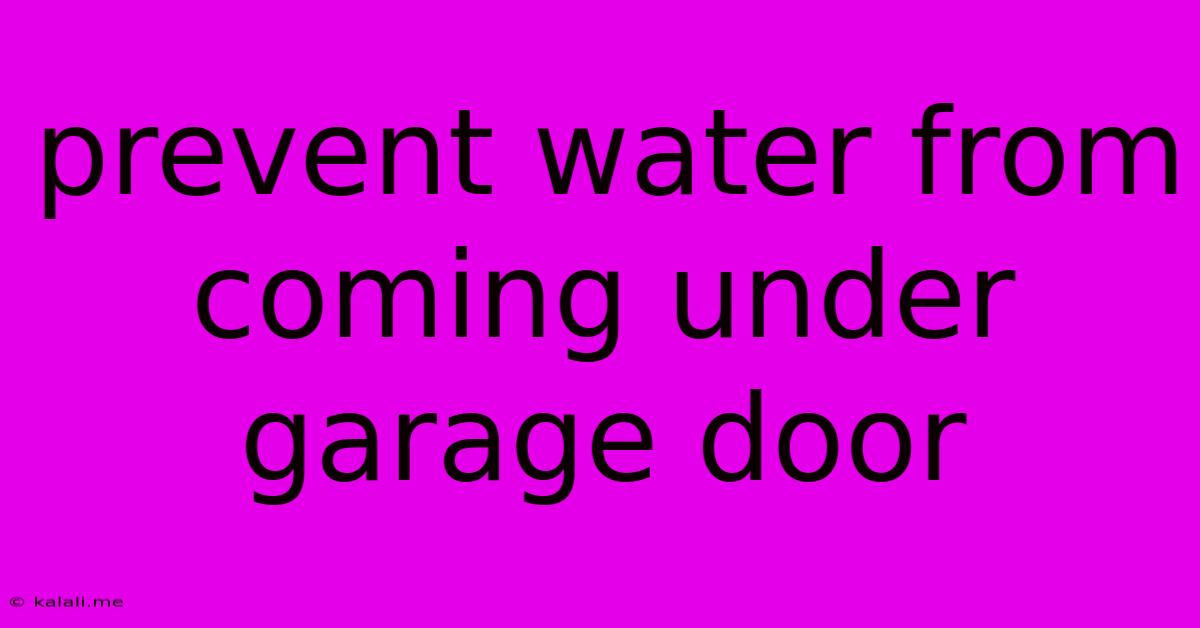Prevent Water From Coming Under Garage Door
Kalali
Jun 08, 2025 · 3 min read

Table of Contents
Preventing Water from Coming Under Your Garage Door: A Comprehensive Guide
Water seeping under your garage door is a common problem, leading to dampness, mold growth, and potential damage to your belongings and garage structure. This frustrating issue can often be addressed with relatively simple solutions. This guide will explore the causes of this problem and offer practical, step-by-step solutions to keep your garage dry and protected.
Why is water getting under my garage door? This is usually due to a combination of factors including poor weather sealing, uneven garage floor, and a poorly fitted door. Understanding these underlying causes is the first step towards effective prevention.
Common Causes of Water Under the Garage Door:
- Gaps and Cracks: Even small gaps between the garage door and the threshold allow water to seep in, especially during heavy rainfall or snowmelt. Wear and tear on the door's weather stripping is a major culprit.
- Improper Installation: An incorrectly installed garage door, or one that's not properly aligned, leaves significant gaps for water intrusion. This is particularly true for older garage doors.
- Uneven Garage Floor: A sloped or uneven garage floor can direct water towards the garage door, forcing it under the seal.
- Damaged Weather Stripping: The weather stripping (seal) at the bottom of the door is the primary defense against water. Damage, deterioration, or a poor-quality seal allows water easy access.
- Poor Drainage: Inadequate drainage around the garage can cause water to pool near the door, increasing the chances of water ingress.
- Damaged Threshold: The threshold itself – the piece of concrete or metal at the bottom of the garage door opening – can be cracked or damaged, allowing water to seep underneath.
Effective Solutions to Prevent Water Intrusion:
1. Inspect and Replace Weather Stripping:
- Assessment: Carefully examine the weather stripping along the bottom of your garage door. Look for cracks, tears, or areas where it's pulling away from the door. If you find any damage, replacement is necessary.
- Replacement: Many home improvement stores sell replacement weather stripping in various materials (rubber, vinyl, foam). Measuring the existing strip before purchasing is crucial. Replacement involves carefully removing the old strip and adhering the new strip using adhesive. Ensure a snug, tight fit.
2. Adjust the Garage Door:
- Alignment: If the garage door isn't properly aligned, it might not seal completely against the threshold. Minor adjustments can often be made using the door's adjustment mechanisms. Consult your garage door's manual or seek professional assistance if you are unsure.
- Lubrication: Regular lubrication of the garage door's moving parts ensures smooth operation and prevents excessive wear and tear, which can lead to gaps in the seal.
3. Improve Drainage:
- Grading: Ensure the ground around your garage slopes away from the door to prevent water from accumulating near the threshold. This might require grading the soil or adding drainage channels.
- Gutters and Downspouts: Ensure your gutters and downspouts are clean and directing water away from the garage. Extending downspouts further away from the garage foundation is highly beneficial.
4. Repair or Replace the Garage Door Threshold:
- Inspection: Thoroughly inspect the garage door threshold for cracks or damage. Small cracks can often be repaired using concrete sealant or epoxy. However, extensive damage usually requires replacement.
- Replacement: If replacement is necessary, this requires some DIY skills or professional assistance. Ensure the new threshold is installed level and correctly sealed to prevent water ingress.
5. Install a Garage Door Seal:
- Types: Consider installing a secondary seal, such as a garage door bottom seal, which creates an additional layer of protection against water infiltration. These are readily available at hardware stores and come in various materials and designs.
- Installation: Follow the manufacturer's instructions for installation. These seals typically adhere to the bottom of the garage door.
By addressing these potential problem areas, you can significantly reduce or eliminate water from entering under your garage door, safeguarding your property and belongings from water damage. Remember, preventative maintenance is key to a long-lasting, watertight garage.
Latest Posts
Latest Posts
-
Match Any Character Including Newline Regex
Jun 08, 2025
-
Who Does God Speak To In The Bible
Jun 08, 2025
-
Why Does My Heater Smell Musty
Jun 08, 2025
-
How Long Will Refrigerator Stay Cold
Jun 08, 2025
-
What Is The Opposite Of Dense
Jun 08, 2025
Related Post
Thank you for visiting our website which covers about Prevent Water From Coming Under Garage Door . We hope the information provided has been useful to you. Feel free to contact us if you have any questions or need further assistance. See you next time and don't miss to bookmark.